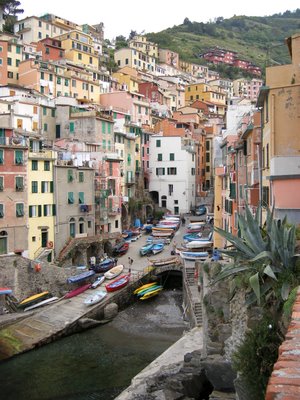holy squid!
Yesterday's New York Times online lists 'guilt-free fish' in Holy Mackerel... which happens to omit a class of seafood I've been thinking about since I prepared a member the other day with sublime results: cephalopods. Calamari are probably no big deal to anyone who enjoys seafood, but can you recognize a well-cooked octopus? Let alone the difference between a polpo and a moscardino? (both translate as 'octopus' but are different species: moscardini are littler critters)
My accidental discovery of the culinary possibilities of seppie, or cuttlefish, began with an exasperating trip to the market where my normal fishmongers were closed and the one I found open had nothing I knew how to prepare or could purchase without selling a kidney. So I bought a kilo of cheap and hideous seppie, filthy in their own ink. I got the fishman to clean them for me, batting eyelashes and asking very very nicely. The cleaning is no small task -- I would have mangled them if I'd done it myself. Like all cephalopods, seppie have a creepy, alien anatomy : an oblong cartiledge familiar to bird owners as the white thing for Tweety to sharpen his beak on, disporportionately large eyes, a beak and ring of teeth hidden at the base of the tentacles. The fishman wrapped the pieces up neatly, still in their own ink, and I cycled home to get them in the fridge. I marinated them for about an hour in the juice of a lemon, olive oil and a little salt, then grilled them on a cast-iron griddle about 8 minutes a side, deglazed the griddle with a glug of white wine and drizzled the juices over top.
Prepared simply, the seppie were fabulous: tender and the sea flavors undisguised. My friends and I finished our portions and fought to wipe the pan with pieces of bread, not leaving a drop of inky sauce wasted.
Which brings me back to the omission of these mollusks from the guilt-free fish list. The over-fishing of certain popular fishes, like Chilean seabass, was a major motivation for the NYTimes article. There are many underused fishes deserving of fine restaurant and home cook attention. But there are also the throw-away fishes that wind up trailing at the end of a fisherman's line, often equally deserving of a place at table. As a child I was told stories of how fisherman in my native North Carolina in recent history considered shrimp nothing more than bait. Having cleaned several times my own weight in shrimp, I understand how these weird underwater bugs might seem unworthy of the effort to render them edible. But today we rarely see them with their ugly faces still attached -- they come decapitated, shelled, deveined, without legs and often precooked to our markets. I recently pointed out cicale, or canocchie, to my father as an example of the unfamiliar seafoods available here. He responded, "They have those are in North Carolina too. But no one eats them."
I recently pointed out cicale, or canocchie, to my father as an example of the unfamiliar seafoods available here. He responded, "They have those are in North Carolina too. But no one eats them."
While it is possible to inadvertently pierce a lip trying to eat what little meat is in the cicala tail, the flavors are rich and worth a little effort. They are often included whole in a zuppa di pesce, a fish stew, for the depth these flavors add to the sauce. I can imagine them as an addition to fish stocks, and they'd make a marvelous bisque.
So here is my own fish list, of the Italian seafoods I think are worth some attention and certainly deserving of a fate more dignified than bait. Italian names are followed by a rough translation to English and the scientific name for specificity. These are no beauty queens, but delicious, I promise.
Part I: Cephalopods
polpo -- octopus (Octopus vulgaris)
moscardino -- baby octopus (Eledone moschata)
moscardino bianco -- baby white octopus (Eledone cirrhosa)

calamaro -- squid (Loligo vulgaris)
calamaretto -- baby squid (Alloteuthis media)
seppia -- cuttlefish (Sepia officinalis)
totano -- squid (Ilex coindetii)
My accidental discovery of the culinary possibilities of seppie, or cuttlefish, began with an exasperating trip to the market where my normal fishmongers were closed and the one I found open had nothing I knew how to prepare or could purchase without selling a kidney. So I bought a kilo of cheap and hideous seppie, filthy in their own ink. I got the fishman to clean them for me, batting eyelashes and asking very very nicely. The cleaning is no small task -- I would have mangled them if I'd done it myself. Like all cephalopods, seppie have a creepy, alien anatomy : an oblong cartiledge familiar to bird owners as the white thing for Tweety to sharpen his beak on, disporportionately large eyes, a beak and ring of teeth hidden at the base of the tentacles. The fishman wrapped the pieces up neatly, still in their own ink, and I cycled home to get them in the fridge. I marinated them for about an hour in the juice of a lemon, olive oil and a little salt, then grilled them on a cast-iron griddle about 8 minutes a side, deglazed the griddle with a glug of white wine and drizzled the juices over top.
Prepared simply, the seppie were fabulous: tender and the sea flavors undisguised. My friends and I finished our portions and fought to wipe the pan with pieces of bread, not leaving a drop of inky sauce wasted.
Which brings me back to the omission of these mollusks from the guilt-free fish list. The over-fishing of certain popular fishes, like Chilean seabass, was a major motivation for the NYTimes article. There are many underused fishes deserving of fine restaurant and home cook attention. But there are also the throw-away fishes that wind up trailing at the end of a fisherman's line, often equally deserving of a place at table. As a child I was told stories of how fisherman in my native North Carolina in recent history considered shrimp nothing more than bait. Having cleaned several times my own weight in shrimp, I understand how these weird underwater bugs might seem unworthy of the effort to render them edible. But today we rarely see them with their ugly faces still attached -- they come decapitated, shelled, deveined, without legs and often precooked to our markets.
 I recently pointed out cicale, or canocchie, to my father as an example of the unfamiliar seafoods available here. He responded, "They have those are in North Carolina too. But no one eats them."
I recently pointed out cicale, or canocchie, to my father as an example of the unfamiliar seafoods available here. He responded, "They have those are in North Carolina too. But no one eats them."While it is possible to inadvertently pierce a lip trying to eat what little meat is in the cicala tail, the flavors are rich and worth a little effort. They are often included whole in a zuppa di pesce, a fish stew, for the depth these flavors add to the sauce. I can imagine them as an addition to fish stocks, and they'd make a marvelous bisque.
So here is my own fish list, of the Italian seafoods I think are worth some attention and certainly deserving of a fate more dignified than bait. Italian names are followed by a rough translation to English and the scientific name for specificity. These are no beauty queens, but delicious, I promise.
Part I: Cephalopods
polpo -- octopus (Octopus vulgaris)

moscardino -- baby octopus (Eledone moschata)

moscardino bianco -- baby white octopus (Eledone cirrhosa)

calamaro -- squid (Loligo vulgaris)

calamaretto -- baby squid (Alloteuthis media)

seppia -- cuttlefish (Sepia officinalis)

totano -- squid (Ilex coindetii)

























